Stories
Annie Bonza
1940-

Annie Bonza (Cole, as she was then) moved from home-town Te Kuiti to Auckland in 1956 with the vision of making beautiful clothes. Serving her apprenticeship as a cutter/designer at Chadwick and Bray, a large clothing manufacturer with 30 machinists, Annie was taught pattern drafting and 18 months later was designing half the company’s range.
After finishing her apprenticeship, Annie left Chadwick and Bray to take up a role as designer at Pour Vous. Owned by Joy Nesbit and Colleen Frei, Pour Vous garments were stocked at department stores and salons all over New Zealand. One of Annie's designs for Pour Vous was highly commended in the 1962 Golden Shears Awards.
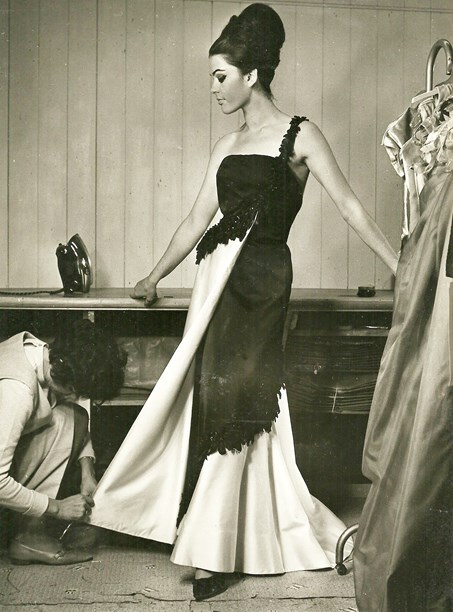
While working at Pour Vous, Annie entered the 1962 Golden Shears Awards. She was highly commended for this satin gown. Image © Pour Vous.
Despite falling in with the theatre and music scene (she was once taken to meet Louis Armstrong), Annie felt stifled by sheltered New Zealand. She made a brave move for a young woman of that time, and she headed to Australia. In Sydney, she designed for the resort-wear label Robert White, producing stylish afternoon and cocktail wear. Her claim to fame then was when the first woman to go topless in Sydney appeared on the front page of the Sunday paper, wearing one of Annie’s dresses. "She had cut the bodice out of this very elegant dress I’d designed so her breasts could poke through. I was outraged!"
In Australia, Annie married and had a son with radical Australian artist Mike Brown, a leader in the Australian Avant-Garde movement. Mike and his friends encouraged Annie to view her art as a means of creative expression and social commentary. "Mike was so anti-establishment. To be honest, I didn’t really understand what all the fuss was about," Annie recalls. "But being in Sydney and around Mike changed the way I thought about fashion – I became a lot more alternative. I remember coming back to New Zealand at that time and people looking at what I wore with disdain. It was if I’d come from another planet. I was always a bit surprised when people reacted in a hostile way."
Mixing with Mike’s cohort of 'out-there' artists and designers helped give Annie the chutzpah it took for a young woman in the 60s to launch out with her own designs. The label name she chose was Annie Bonza – a play on the nickname she’d been given by sculptor Robert Klippel, 'Bonza Annie'. When her marriage with Mike ended, Annie decided to take on the label name as her own.

Annie's hand-painted culottes featured in Vogue Australia in 1966.
Annie moved back to New Zealand in 1966. It took a year of experimentation before she felt ready to open her own boutique – quite a risk for a young solo mother, especially as the concept of a 'boutique' was only just beginning in this country at that time. With the help of a friend, Annie found premises in Jervois Road and opened Boutique 202.
Annie quickly made a name for herself as one of the 'it' designers amongst Auckland trend-setters of the time. She began dressing the stars of TV music shows C’mon and Victorian Music Hall, commissions which gave her the opportunity to be as wild as her imagination would allow, while working within the confines of black and white television.

Annie visiting Auckland Museum's Volume exhibition where the garment she designed for The Chicks' Judy Donaldson in 1967 was on display.
With her background designing for high-end labels, the finish on her garments placed her creations at a different level to most of the designs being produced by other with-it fashion designers of the time, many who sold from the new Cook Street Market.
Annie moved her business to the quirkier Theatre Lane (off Queen Street) to be closer to her clientele, and quickly established a reputation for her distinctive braid 'doodling' and writing on garments.
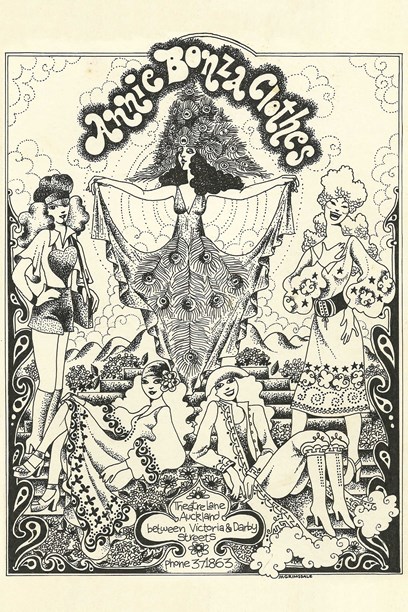
Advertisement for Annie's boutique in Theatre Lane, Auckland. Image by Murray Grimsdale, © Annie Bonza.
Encouraged by the braid-obsessed 1970s fashions, she soon developed a signature style based on a technique she had become fascinated in many years earlier. "When I started my apprenticeship in the 1950s there was no decoration on clothing other than artificial flowers made in the fabric of the dress. I remember they were made by a wonderfully talented refugee couple who settled here after the war – they would mould the flower petals on spoons. I always felt there should be more decoration. When I worked at Chadwick and Bray they had all these pre-war patterns of cornelli designs. These intrigued me, and I was able to stay behind after work and play. But I could never get the hang of doing cornelli so I substituted with braid."
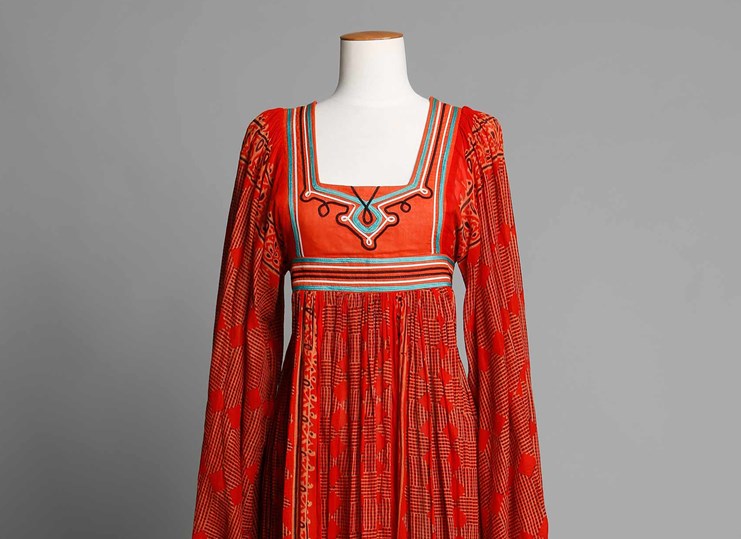
This dress from the early 1970s features cornelli detail on the bodice.
One of Annie’s first attempts at braiding on clothing was influenced by an Austrian friend. "She was a forceful character and had a huge influence over everyone. She and her sister had been smuggled out of Austria in the early part of the war, and they’d ended up in England in a women’s prison. They never saw their parents again. The only thing she had from Austria was a plum wool curtain with beige cording. It was thick, and the bottom of it was cornellied with a peasant design. I copied that Austrian design using bright colours on a black velvet skirt. It was pretty in-your-face but very effective."
During the time that Annie was in the Theatre Lane boutique she began enjoying New Zealand again, recognising that while it didn’t have the Sydney buzz, it did have a natural and cultural character that was worth celebrating. "The writing and doodling started off as me wanting to be able to say that 'this is Kiwi, this is New Zealand / Aotearoa'. It was aimed at an identity thing."


Annie's boutique in Theatre Lane, Auckland.
Annie’s braiding took on an unintentional Māori feel, something she now attributes to the influence of the famous weaver Dame Rangimarie Hetet, who taught her Māori craft when she was at Te Kuiti High School.
Annie was also in a relationship with artist Murray Grimsdale, and the two collaborated on many projects. Murray added painted images to garments or created more illustrative designs for embroidery.

Annie collaborated with illustrator Murray Grimsdale to design this coat in 1970.
Annie Bonza’s reputation for colourful, distinctive garments, often embellished with braid, escalated when, in 1971, she won the evening/hostess gown section of the Benson & Hedges Fashion Design Awards.
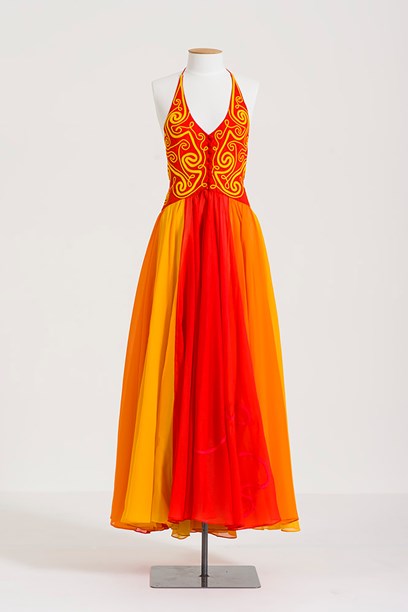
Annie won the eveningwear category of the 1971 Benson & Hedges Fashion Design Awards with this chiffon and braid-work dress.
All the attention eventually got to Annie, and soon she couldn’t keep up; she struggled to juggle the hats of business woman, marketer, designer and mother. In 1974 she sold up and moved to Waikino. There, she played at being a hippie – a lifestyle characterised by lots of parties, not much creativity and a level of reckless abandon she sensed was not doing her any favours. Now with another son in tow, Annie escaped with her boys to Rarotonga, in the Cook Islands, where she spent the next seven years.
The Polynesian sense of style had a huge impact on Annie’s psyche. "The women in Rarotonga really celebrated being women and wore very feminine clothing along with the flowers in their hair. They reveled in their femininity. I came from a society where women were self conscious about being a woman, but in the Cook Islands they were full-on, just loving it."
Annie kept herself busy by designing exotic creations for the tourist market that celebrated the sunshine and beauty of the Cook Islands. Annie opened a shop, Mekameka, in Rarotonga, catering mainly for tourists, but her muumuu’s for local women were also highly sought after. "The other thing I loved about women in Rarotonga was that when they liked what someone else was wearing they’d say they were ‘jiel-us’. Europeans would never say they’re jealous so I found it quite shocking, until I realised the honesty behind the statement was a compliment in itself."
Annie returned from Rarotonga to Auckland in 1984. She worked as a consultant designer for several years, before opening again in Jervois Road, Herne Bay in 1988. Once again, it was her distinctive braiding that became her trademark, along with her head-turning window displays, usually featuring her most glamorous creations. "The shop was simple but effective. I did enjoy making things for the window; making things to turn people on. I remember displaying a strapless dress – I used red guipure roses all over the bodice which I filled in with green braid, and it had a huge tulle skirt. People really reacted to it. It had a bit of magic to it, I suppose. My clientele were women who lived locally, largely attracted by the window. And winning the Benson and Hedges in 1989 gave me a lot of publicity and drew people to look at what I was doing. I ended up designing a lot of wedding dresses."
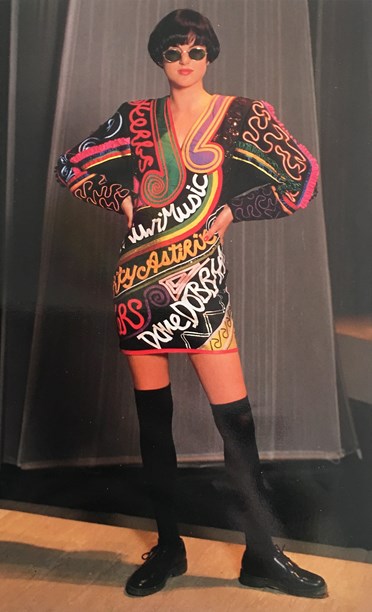
This dress by Annie Bonza won the Lifestyle section of the Benson & Hedges Fashion Design Awards in 1989.
In 1996, Annie moved back to Rarotonga. She took on private commissions and started a small business, before returning to New Zealand in 2010.
Looking back over the years, the works she recalls most vividly have more to do with the people who wore them than the garments themselves. She felt humbled to make weaver Rangimarie Hetet’s outfit when she became a Dame. She had the honour of making a dress for Dame Te Atairangikaahu, the late Māori Queen. And in 1991, she made a wedding gown from Fijian tapa for Adi Litia, the daughter of the then Fijian Prime Minister Ratu Sir Kamisese Mara.
It is an intimate undertaking, creating something that will make its wearer feel beautiful. Through the process, some designers and their clients form close attachments. It’s these friendships that Annie considers to have been one of her real privileges in life.
Text by Shona Jennings. Banner image © Metro magazine.
Last published September 2013.